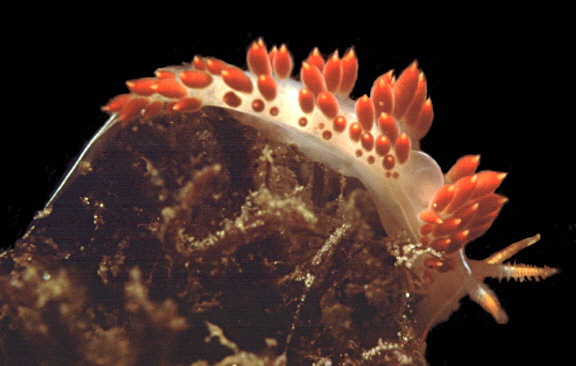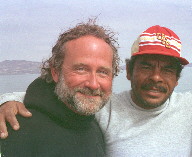
Flabellina trilineata
Flabellina trilineata (O'Donoghue, 1921)
This distinctive eolid has a grayish white body coloration, with three opaque white lines: one running down the center of the dorsum and then bifurcating anteriorly, continuing middorsally to the tips of each cephalic tentacle; the other lines extend lengthwise along each side of the animal's body. Ceratal cores and tips of rhinophores are orange to red. The rhinophores are obviously annulate. This species can reach up to 36 mm in total length.
It has been reported to feed on the hydroids Eudendrium and Tubularia crocea. It occurs along the Pacific coast of North America, from Lisianski Inlet, Alaska, to Bahia Tortugas, Baja California Sur, Mexico.
A short historical note may be in order. Charles H. O'Donoghue named this species 75 years ago! In the preface to his article, "Nudibranchiate Mollusca from the Vancouver Island Region," published in the Transactions of the Royal Canadian Institute, Dr. O'Donoghue wrote: "The marine fauna of the coasts of British Columbia is particularly rich and varied and yet, so far, no description of the Nudibranchiata of this region has been published. Indeed this group of animals has only received comparatively little attention on the Pacific coasts of North America in general. One result of this is, that the number of species recorded is not so large as from the western coasts of Europe and this is probably due to a lack of workers and not a lack of material. It seems advisable therefore to provide a diagnosis of the species so far collected in sufficient detail to render their recognition easy and certain...It is rather fuller than is necessary in some groups of animals since Nudibranchs appear to be subject to a wide range of individual variation in the matter of size, colour, etc...A completely satisfactory account of any form necessitates the examination of living specimens; and the establishing of a colour variety such as Bergh has done...on preserved material is a hazardous proceeding and can only be justified by subsequent reference to living material....The colour of living members of the same species is subject to considerable variation and in some instances the colours of specimens collected here differ from those from Monterey described by MacFarland and to this I have collected attention when necessary. It is not meant to imply that MacFarland's account is inaccurate, but simply that the specimens obtained here are somewhat different. There is of course a distinct difference in the local environment, for on the whole there is considerably more sand at Monterey Bay than anywhere I have collected."
Honoring the Diamond Anniversary of the naming of this species, one can see significant growth in our understanding of the nudibranch fauna, and respect the foresight of some of Dr. O'Donoghue's comments: we have more workers, the species count of Pacific North America's coast is more than equal to that of the western coasts of Europe, and investigators today are aware of the evolutionary principle and significance of biological variation. His comments on geographical and habitat differences are fundamental to our modern understanding of the biology and zoogeography of these animals.
Photos and text by Dr. Hans Bertsch

192 Imperial Beach Blvd. #A |
